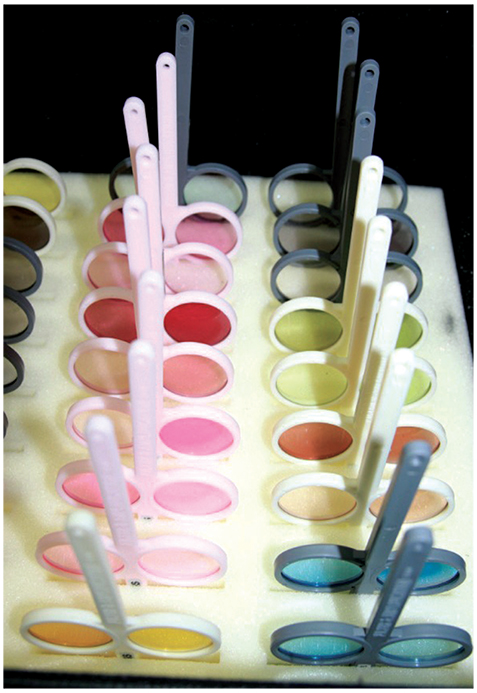Korean J Ophthalmol.
2014 Apr;28(2):159-163. 10.3341/kjo.2014.28.2.159.
Specific Visual Symptoms and Signs of Meares-Irlen Syndrome in Korean
- Affiliations
-
- 1Department of Ophthalmology, Korea University College of Medicine, Seoul, Korea. ansaneye@hanmail.net
- 2MISVIS Ltd., Seoul, Korea.
- KMID: 1792110
- DOI: http://doi.org/10.3341/kjo.2014.28.2.159
Abstract
- PURPOSE
To discriminate the visual symptoms and signs of Meares-Irlen syndrome (MIS) and nonspecific dyslexia from other ophthalmologic diseases (NODs).
METHODS
Forty-five patients were enrolled. Thirty four of the patients with MIS whose symptoms improved with tinted lenses comprised MIS group. The other 11 patients whose reading difficulty improved with other ocular therapy and did not require tinted lenses comprised NODs group. The main symptoms causing dyslexia and associated ocular diseases were evaluated.
RESULTS
The mean age was 17.9 +/- 9.5 years in MIS group, and 19.3 +/- 11.0 years in NODs group. In MIS group, the most common symptoms while reading were difficulty to move lines (85%), doubling (53%), and difficulty in bright condition (27%). On the other hand, blurring was the most common symptom in NODs group (45%). The associated ocular diseases in the two groups were refractive error (79% and 73%), dry eye (29% and 18%), and exophoria (6% and 27%), respectively.
CONCLUSIONS
Doubling, difficulty to move lines, and difficulty in bright condition while reading are main specific symptoms in MIS compared to nonspecific dyslexia from other ophthalmologic disorders.
Keyword
MeSH Terms
Figure
Reference
-
1. Stein J. The magnocellular theory of developmental dyslexia. Dyslexia. 2001; 7:12–36.2. Nandakumar K, Leat SJ. Dyslexia: a review of two theories. Clin Exp Optom. 2008; 91:333–340.3. Meares O. Figure/ground, brightness contrast, and reading disabilities. Visible Lang. 1980; 14:13–29.4. Irlen H, Lass MJ. Improving reading problems due to symptoms of scotopic sensitivity syndrome using Irlen lenses and overlays. Education. 1989; 109:413–417.5. Williams GJ, Kitchener G, Press LJ, et al. The use of tinted lenses and colored overlays for the treatment of dyslexia and other related reading and learning disorders. Optometry. 2004; 75:720–722.6. Evans BJ. The need for optometric investigation in suspected Meares-Irlen syndrome or visual stress. Ophthalmic Physiol Opt. 2005; 25:363–370.7. Park SH, Kim SH, Cho YA, Joo CK. The effect of colored filters in patients with Meares-Irlen syndrome. J Korean Ophthalmol Soc. 2012; 53:452–459.8. Chase C, Ashourzadeh A, Kelly C, et al. Can the magnocellular pathway read? Evidence from studies of color. Vision Res. 2003; 43:1211–1222.9. Helveston EM. Scotopic sensitivity syndrome. Arch Ophthalmol. 1990; 108:1232–1233.10. Livingstone MS, Rosen GD, Drislane FW, Galaburda AM. Physiological and anatomical evidence for a magnocellular defect in developmental dyslexia. Proc Natl Acad Sci U S A. 1991; 88:7943–7947.11. Liberman IY, Shankweiler D, Orlando C, et al. Letter confusions and reversals of sequence in the beginning reader: implications for Orton's theory of developmental dyslexia. Cortex. 1971; 7:127–142.12. Fluss J, Ziegler J, Ecalle J, et al. Prevalence of reading disabilities in early elementary school: impact of socioeconomic environment on reading development in 3 different educational zones. Arch Pediatr. 2008; 15:1049–1057.13. Skottun BC, Skoyles J. Dyslexia: sensory deficits or inattention? Perception. 2007; 36:1084–1088.14. Skottun BC, Skoyles JR. Attention, reading and dyslexia. Clin Exp Optom. 2006; 89:241–245.
- Full Text Links
- Actions
-
Cited
- CITED
-
- Close
- Share
- Similar articles
-
- The Effect of Colored Filters in Patients with Meares-Irlen Syndrome
- Clinical Characteristics of Patients With Dyslexia in Korea : Correlation With Meares-Irlen Syndrome
- Functional Magnetic Resonance Imaging Findings in Meares-Irlen Syndrome: A Pilot Sudy
- Correlation Between Displacement of Optic Chiasm on MR and Visual Symptomas and Signs
- The Homogeneity of Phenomenology of Gerstmann Syndrome: The Study in Patients with Alzheimer's Disease


